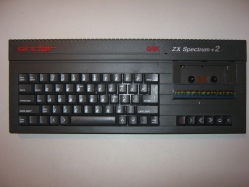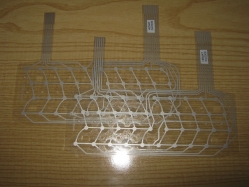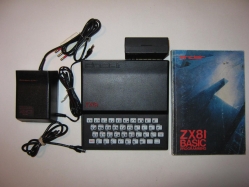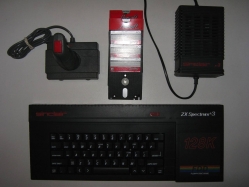
Autopsy:
from Wikipedia homepage:
The ZX Spectrum +2A was produced to homogenise Amstrad’s range in 1987. Although the case reads “ZX Spectrum +2″, the +2A/B is easily distinguishable from the original +2 as the case was restored to the standard Spectrum black.
The +2A was derived from Amstrad’s +3 4.1 ROM model, using a new motherboard which vastly reduced the chip count, integrating many of them into a new ASIC. The +2A replaced the +3′s disk drive and associated hardware with a tape drive, as in the original +2. Originally, Amstrad planned to introduce an additional disk interface, but this never appeared. If an external disk drive was added, the “+2A” on the system OS menu would change to a +3.
As with the ZX Spectrum +3, some older 48K, and a few older 128K, games were incompatible with the machine. The ZX Spectrum +2B signified a manufacturing move from Hong Kong to Taiwan later in 1987.
source: wikipedia
Sound fix diagram here. (pdf)
from Cristian Secară Homepage:
The first release (the +3) has a fatal hardware mistake: the 128K sound output is completely distorted.
- Tech explanation: the analog output of the AY-3-8912 sound chip was intended to be amplified by a one stage common-emitter transistor. In practice, they have forgot to put a resistor to the transistor’s emitter. The result: the transistor works in switch-mode – the sound is converted from analog multi-level amplitude to digitized two-level amplitude, same as the old 48K sound system.
source: secarica.ro ay8912 Demos

Autopsy:
The original Plus2 (in the grey case) was released in 1987 to get away from the old Spectrums now that Amstrad had taken over. It was very different from previous Spectrums and had a proper typewriter keyboard, built-in casette recorder and 2 joystick ports.
For some unknown reason Amstrad later released a +2A in a black case which is actually a Plus3 with a casette recorder instead of a disk drive.
from Wikipedia:
The ZX Spectrum +2 was Amstrad’s first Spectrum, coming shortly after their purchase of the Spectrum range and “Sinclair” brand in 1986. The machine featured an all-new grey case featuring a spring-loaded keyboard, dual joystick ports, and a built-in cassette recorder dubbed the “Datacorder” (like the Amstrad CPC 464), but was in most respects identical to the ZX Spectrum 128. The main menu screen lacked the Spectrum 128′s “Tape Test” option, and the ROM was altered to account for a new 1986 Amstrad copyright message.
These changes resulted in minor incompatibility problems with software that accessed ROM routines at certain addresses. Production costs had been reduced and the retail price dropped to £139–£149.
The new keyboard did not include the BASIC keyword markings that were found on earlier Spectrums, except for the keywords LOAD, CODE and RUN which were useful for loading software. This was not a major issue however, as the +2 boasted a menu system, almost identical to the ZX Spectrum 128, where one could switch between 48k BASIC programming with the keywords, and 128k BASIC programming in which all words (keywords and otherwise) must be typed out in full (although the keywords are still stored internally as one character each).
Despite these changes, the layout remained identical to that of the 128.
source: wikipedia

Autopsy:
One of the most common faults on the old “rubber key” spectrums are groups of non working keys. This problem is almost always caused by a worn keyboard membrane.

Autopsy:
from Wikipedia:
The ZX Spectrum is an 8-bit personal home computer released in the United Kingdom in 1982 by Sinclair Research Ltd. Referred to during development as the ZX81 Colour and ZX82, the machine was launched as the ZX Spectrum by Sinclair to highlight the machine’s colour display, compared with the black-and-white of its predecessor, the Sinclair ZX81.
The Spectrum was released in eight different models, ranging from the entry level model with 16 KB RAM released in 1982 to the ZX Spectrum +3 with 128 KB RAM and built in floppy disk drive in 1987.
The Spectrum was among the first mainstream audience home computers in the UK, similar in significance to the Commodore 64 in the USA. The introduction of the ZX Spectrum led to a boom in companies producing software and hardware for the machine, the effects of which are still seen; some credit it as the machine which launched the UK IT industry. Licensing deals and clones followed, and earned Clive Sinclair a knighthood for “services to British industry”.
The C64 was a major rival to the Spectrum in the UK market during the early 1980s. The BBC Microcomputer and later the Amstrad CPC-range were other major competitors.
source: wikipedia

Autopsy:
from Wikipedia:
The Sinclair ZX81 was a home computer released in 1981 by Sinclair Research. It was the follow-up to the Sinclair ZX80. The machine’s distinctive appearance was the work of industrial designer Rick Dickinson.
Video output, as in the ZX80, was to a television set, and saving and loading programs was via an ordinary home audio tape recorder to audio cassette. Like its predecessor it used a membrane keyboard. Timex Corporation manufactured kits as well as assembled machines for Sinclair Research.
In the United States a version with double the RAM and an NTSC television standard was marketed as the Timex Sinclair 1000.
source: wikipedia

Autopsy:
from Wikipedia:
The ZX Spectrum +3 looked similar to the +2 but featured a built-in 3-inch floppy disk drive (like the Amstrad CPC 6128) instead of the tape drive, and was in a black case. It was launched in 1987, initially retailed for £249 and then later £199 and was the only Spectrum capable of running the CP/M operating system without additional hardware.
The +3 saw the addition of two more 16 KB ROMs. One was home to the second part of the reorganised 128 ROM and the other hosted the +3′s disk operating system. This was a modified version of Amstrad’s AMSDOS, called +3DOS. These two new 16 KB ROMs and the original two 16 KB ROMs were now physically implemented together as two 32 KB chips. To be able to run CP/M, which requires RAM at the bottom of the address space, the bank-switching was further improved, allowing the ROM to be paged out for another 16 KB of RAM.
Such core changes brought incompatibilities:
- Removal of several lines on the expansion bus edge connector (video, power, and IORQGE); caused many external devices problems; some such as the VTX5000 modem could be used via the “FixIt” device
- Dividing ROMCS into 2 lines, to disable both ROMs
- Reading a non-existent I/O port no longer returned the last attribute; caused some games such as Arkanoid to be unplayable
- Memory timing changes; some of the RAM banks were now contended causing high-speed colour-changing effects to fail
- The keypad scanning routines from the ROM were removed
- move 1 byte address in ROM
Some older 48K, and a few older 128K, games were incompatible with the machine.
The +3 was the final official model of the Spectrum to be manufactured, remaining in production until December 1990. Although still accounting for one third of all home computer sales in the UK at the time, production of the model was ceased by Amstrad at that point.
source: wikipedia divide homepage divide forum
























































































Recent Comments